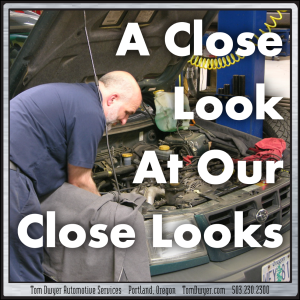
 Is a “free Multipoint Inspection” a deal? Should you trust a “Free Brake Inspection”? Is our own 90-Point Inspection worth your time? Is our Comprehensive Inspection worth the money? Every auto repair shop has a “multipoint inspection” of some type, but some are actually intended to find vehicle problems while others are little more than superficial sales tools for the shop. We think our structured and meticulous inspection process is critical in providing quality care for your vehicle. What makes the difference? Why aren’t we “just trying to sell you something” too? Here are some tips on how to tell the good from the bad in any quality auto inspection, but also some insight to our own inspection process and why we rely so heavily on it…
Is a “free Multipoint Inspection” a deal? Should you trust a “Free Brake Inspection”? Is our own 90-Point Inspection worth your time? Is our Comprehensive Inspection worth the money? Every auto repair shop has a “multipoint inspection” of some type, but some are actually intended to find vehicle problems while others are little more than superficial sales tools for the shop. We think our structured and meticulous inspection process is critical in providing quality care for your vehicle. What makes the difference? Why aren’t we “just trying to sell you something” too? Here are some tips on how to tell the good from the bad in any quality auto inspection, but also some insight to our own inspection process and why we rely so heavily on it…
Who Needs An Inspection?
Quality vehicle inspections are intended to identify safety and reliability issues and prevent many breakdowns. Inspections or diagnosis (there is a difference!) are certainly appropriate when there’s a problem with your vehicle, but you shouldn’t wait for a failure. Regular vehicle inspections help you stay on top of maintenance in real time rather than waiting for the next Mileage Interval or (even worse!) not having a maintenance plan at all. We recommend every vehicle be physically inspected after the first 24,000 miles or so, and on a continuing basis thereafter.
- For reasonably-well-maintained vehicles with less than about 30-45,000 miles, inspections are less important and may find few issues at all. If a vehicle has over 60,000 miles, hasn’t been well maintained, or already has problems, it should be inspected more often and you can expect a longer list of repairs.
- Inspections can help decide if an expensive repair is ‘worth it’ or not. For example a $5000 engine replacement on a 10-year-old car might make sense, but might not if it still needs thousands more in additional service or repairs to be roadworthy.
- You should always have a THOROUGH inspection done of any vehicle you’re thinking about buying BEFORE YOU BUY IT!
- An inspection lets you know about any potential problems if you’re getting ready to sell or give a vehicle to friends or family.
Why Can’t I Just Go By Service Mileage Intervals?
Mileage-based Service Menus are packages of services “due” at major mileage intervals like 30-, 60-, and 90,000 miles. They’re built around “average” drivers driving “average” vehicles in “average” conditions and don’t consider the impact of your personal driving style or local conditions. They don’t consider services done between mileage intervals, nor can they reliably predict things like brake or tire wear, fluid leaks, unusual wear, or other potential failures. They don’t consider any other, possibly more important needs the vehicle may have that aren’t on the list. In short, they don’t consider the actual condition of you or your vehicle.
In our opinion, Service Menus are tools for Dealers to sell highly-profitable services without the hard work of actually evaluating vehicles. A shop can sell their expensive Service Package first and then make the dreaded “second call” to sell more (and possibly more important) work “noticed” once your vehicle “got up on the rack”. Mileage Menu recommendations can be useful guides and we certainly consider them in our own vehicle evaluations, but they weren’t designed with you in mind. We think relying on them is a flawed way to care for your vehicle… at best.
Questions To Ask About A Vehicle Inspection
To know the value of a vehicle inspection, you have to know what the shop is doing when they’re “inspecting” your vehicle.
- Who’s doing the inspection? There’s no substitute for training and experience in anyone examining your car. Make sure your inspector is ASE-Certified; ASE-Master-Certified if possible.
- How deep does the inspection go?
- Vehicles should be road-tested to expose driving issues that don’t leave visual evidence.
- Brake pads can be superficially examined with wheels in place, but the wheels need to be removed to be properly measured for service.
- Vehicles should be “put up on the rack” to relieve pressure for proper suspension check.
- Things like your timing belt can’t be checked directly, so the shop should have complete records of when these inaccessible components were last addressed.
- How long should an inspection take? Quality inspections can’t be done quickly or sitting in a shop’s parking lot. Our inspections take time; between road-testing, physical inspection, history review, technical service and recall searches we need a vehicle at least two hours for a 90-point inspection and at least four hours for a Comprehensive Inspection (see below).
- What happens with the results? Not all the issues found in a vehicle inspection will be equally important, so don’t settle for just a list of potential repairs. Make sure your results are explained with safety or breakdown issues highlighted. We fully explain every result of the inspection in plain language and prioritize our service recommendations by safety, breakdown prevention, and maintenance. You can schedule any needed work at the time of inspection or bring it back to us at a time that works better for you.
Why Not A Specialty Shop?
A proper vehicle inspection should cover the entire vehicle equally. Auto shops that specialize in one type of service (like mufflers, brakes, tires, or convenience oil changes) have lots of incentive to find problems in their specialty but little incentive to consider the rest of the car. Besides, it makes sense to get your vehicle inspected at a shop that can fix everything they find.
Tom Dwyer Inspection Process
Our inspection and repair process is designed to give you the accurate information you need to drive more safely and confidently, and to get the most value from your vehicle maintenance dollars. We have three levels of inspection, each with a unique role in mechanical maintenance and upkeep…
90-point Inspection
This is our first-level inspection; what other shops commonly call an “in-depth” or “multipoint” inspection. In ours, an ASE-Certified Technician does the most thorough inspection possible without invasive disassembly. Combined with regular Minor Interval Services and a Comprehensive Inspection every 12,000-18,000 miles, 90-Points are a great way to proactively stay on top of your vehicle’s needs… or to get some “peace of mind” before a big road trip.
Comprehensive Inspection (IFR)
Also called an “Inspection-For-Repair” or IFR, this is a much deeper version of our 90-Point Inspection. The IFR is a 130-point physical examination and evaluation of every reasonably accessible system of your vehicle… we remove wheels to measure brake pads, pull a spark plug to measure wear, dry-park-test the steering and suspension, and much more. It also includes a vehicle road test, service history review, and Technical Service Bulletin and Active Recall search. Just ask a Service Advisor to show you one of our IFR forms and they’ll gladly explain how deep and detailed it is!
- We recommend an IFR to all our New Clients to establish a mechanical baseline for their vehicle, and then again every year or so.
- Plan at least half a day for an IFR; more if you expect service will be necessary. Plan to leave your vehicle with us for 4 working hours (8a-noon or noon-5pm) for the inspection alone. If you anticipate service will be needed then plan to leave the vehicle with us for the day and get it to us as early as possible.
- A Comprehensive Inspection is thorough, but it’s NOT a diagnosis. In some cases an IFR might discover an obvious problem with an obvious solution, but in other cases a more in-depth diagnostic exam may be needed.
- A Comprehensive Inspection DOESN’T cover EVERY system. Some parts like timing belts or head gaskets can’t be accessed without major work. We can only go by mileage recommendations on these inaccessible components.
- A Comprehensive Inspection is NOT a crystal ball. We can give our best professional analysis of what’s coming up for your vehicle, but we can’t predict the future. Our IFR is not a guarantee that something won’t fail on your vehicle.
Post-service Checkout (40-point Inspection)
Even many of our longest-term clients don’t even know it, but here are just some of the more than 40 key points we check every time your vehicle is serviced:
- Engine oil and other vital fluid levels are checked (documented if abnormal) and topped off
- Under-hood inspection
- Check and replace any lights or signal bulbs (labor free, in most cases)
- Check and set tire pressures.
- We even make sure your clock is set right!
Having another set of eyes on your vehicle is just one more opportunity to reduce errors, and another way to ensure that every vehicle that leaves our shop is in its best possible mechanical condition.
Pre-Purchase Inspection
We think it’s absolutely essential to get a thorough inspection of any vehicle you intend to buy BEFORE you buy it… we’ve seen all too many vehicles inspected AFTER purchase when unknown problems cost thousands of dollars. The $100-$200 you’ll spend is cheap insurance against the unexpected or the undisclosed. We stopped doing Pre-Purchase inspections in most cases, but if you call our shop we’ll gladly recommend a Pre-Purchase Inspector that we trust.
Only Get An Inspection You Can Trust
Although there are some good inspection processes, far too many shops offer inconsistent once-overs more designed to benefit the Shop instead of the Client. Bad automotive inspections are more than just useless- they can be expensive if you buy a used vehicle already beyond repair, or even dangerous if there’s false security about some critical system actually about to go bad. We’ve developed our industry-leading, multi-level inspection processes through over 30 years of use and refinement for one reason: No one can make intelligent decisions about vehicles without knowing their precise mechanical condition, and a sensible inspection program is the only way to get that information. We want to insure that your budget is directed precisely at your priorities letting you drive more safely and confidently, and get the most value from your vehicle maintenance dollars.










